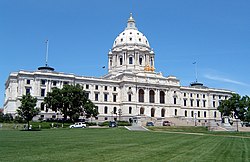Sessions
The legislature met in regular session beginning January 3, 2007 and ending May 21, 2007. A bill passed on February 22 required the state to generate a significant amount of its energy needs from renewable sources. [1]
A special session was convened September 11, 2007 to pass legislature relating to floods in southeast Minnesota and the I-35W Mississippi River bridge. [2]
The legislature re-convened for regular session on February 12, 2008 and adjourned in May.
This page is based on this
Wikipedia article Text is available under the
CC BY-SA 4.0 license; additional terms may apply.
Images, videos and audio are available under their respective licenses.
